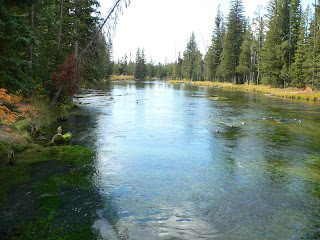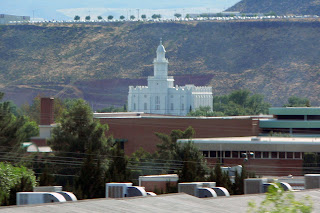
Grand Teton is, to my mind, Aslan's Country. Or Middle Earth. Or any
other fantastically beautiful fictional place you can think of--except
that Grand Teton is real. It's also sort of a strange park. You can drive through large sections of it without ever passing an entry gate, and the Jackson airport is within the park's boundaries. I think if I lived in Jackson, I would go to the park every day! But I don't, so I go as often as weather and travel over Jackson Pass (10% grade) will allow. The long park road opens in March, and it's still pretty snowy there, as you can see above.
The loneliest outhouse in the world:
The fields are populated by buffalo nowadays instead of farmers:
Traveling north on the outer main road of the park (Hwy 191), you sort of follow the Snake River. If you're at Oxbow Bend, take the turnout. You may be surprised that you have seen this scene before--we've had an Ansel Adams photo on the wall every since we've been married, and were startled to find it before our eyes in living color. The larger mountain on the left is Mt. Moran, named for American landscape painter Thomas Moran, who came along on early explorations to help document this amazing place.
Keep going north and you'll come to Jackson Lake. The color of the lake is every childhood dream of summer and water and cool blue ice cream:
Now take the inner road (Teton Park Rd) back toward Jackson. If you go up on Signal Mountain, you'll get a good view of what the surrounding landscape is like:
As you follow Teton Park road south, you'll pass a series of lakes. The smallest one is String Lake. There's a very nice, 3-mile hike around the lake that gives you a great side view of the Teton group:
The way is forested and if you go in the right time of year (August/September), there are wild huckleberries along the way. They have not been domesticated, so you enjoy them when you can. They look like tiny blueberries, with a similar but much stronger flavor, and they have a perfect bull's eye on the end. The shrubs are about two feet high and they like to cover forest hillsides. Y.U.M.
Forest path around String Lake:
String Lake is popular for kayaks and other small boats. It has a swimming area, too, which is refreshing after a summer hike. The water is clear and only about three feet deep at its deepest, so it's pretty warm. Large boulders in the middle make fun destinations for kids.
As you continue southwards back to Jackson, you'll pass Jenny Lake. Jenny Lake is a pretty popular tourist destination because it's so close to Jackson (and because it's pretty!). You can take a ferry across and hike up Cascade Canyon to see Hidden Falls and then go up to Inspiration Point. If you like, you can hike back down and take the ferry back--or hike around the lake (2 or 3 miles) back to your car. Or, if you're REALLY adventurous, you can keep on hiking the canyon up to Alaska Basin, and then it's only 7.5 miles down the other side to the trailhead of South Fork (Teton Canyon from the Idaho side, near Driggs). Um, but that would be a serious backpacking trip.
Hidden Falls:
Inspiration Point:
As to animals, you can see all kinds in Grand Teton. I've seen black bears in the middle of the day, and grizzlies do live up there, too, so keep your bear spray handy. Handy means in your hand or on a holster, NOT in your pack. And learn how to use it, too, because if you spray it all out when the bear is 50 feet away, you'll have nothing left when he's five feet away. Watch the air currents so he gets it, not you. But you are far less likely to see bears as you are chipmunks and lizards and buffalo and elk and these guys, the yellow-bellied marmot:
And that's Grand Teton!





















































